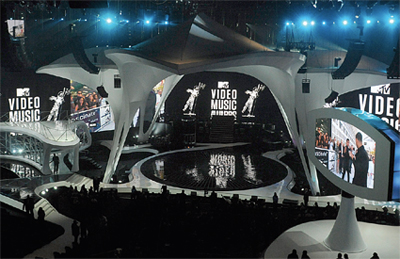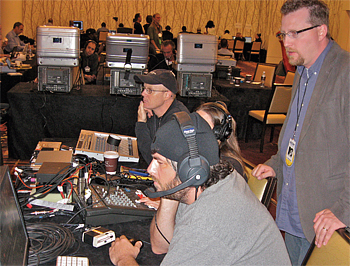MTV VMAs Personify New Media
LOS ANGELES
MTV is about more than just the music, and the Video Music Awards (VMAs) are more about just another Sunday night event broadcast. This year, the VMAs blossomed into a five-day spectacular from Sept. 9-13, that MTV wants to build into something that rivals the NBA's All Star Weekend or a week-long X-Games competition.

Late night comedian Chelsea Handler hosted the MTV Video Music Awards at downtown Los Angeles’ Nokia Theater, Sept. 12. Photo: Frank Miceleta/Getty Images Executive Producer Dave Sirulnik lead the charge on this show's production content while Jeff Jacobs, vice president of production, was at the helm of the event's multi-platform broadcast and digital distribution that centered around the Video Music Awards show held at downtown Los Angeles' Nokia Theater.
"Our audience has grown accustomed to utilizing the latest technology to enjoy all dimensions of the music experience," Jacobs said. "That's why we are expanding the VMAs from a one-night to a five-day experience through multiplatform content sharing and revolutionary approaches to broadcasting enabled by the inexhaustible efforts of a heck of a staff. Those five days include the Monday after the show, which is one of the most highly trafficked days for fan hits on MTV.com"
The VMAs are produced by a consortium comprised of MTV.com, MTV News, MTVMobile and Wireless, MTV International, and MTV Viral Marketing.
"Each year we try to reinvent the palette of what our awards show looks and feels like," said Sirulnick, who is also executive vice president of MTV News. "This year we decided to come back to Los Angeles and design the look of the Sunday night broadcast around the soaring power of mid-20th-century architecture seen through the prism of 2010."
Everyone was goo-goo over Lady Gaga, who won 8 Moonman awards including the prestigious "Video of the Year" coup. But it was host Chelsea Handler who took center stage proclaiming "I am high as a kite!" and managed to drop enough bleeps to satisfy MTV's 18-34 year-old core demographic's desire to gasp "OMG, how can she get away saying that?" which, of course, is part of the flamboyant sex, drugs and rock & roll panache of the event.
MASSIVE NEWS COVERAGE
Starting weeks before the event, MTV News took over the sound stage in the AEG building adjacent to the Nokia Theater and converted it into a massive news room. Over half a dozen reporting teams swarmed the entire VMA production process.

One of the backstage hallway Sony BRC-H700 POV cameras being streamed via the TriCasters over MTV.com "Our audience is everywhere, and it is our job to cover the story from every angle on every platform," said Benjamin Wagner, senior vice president of MTV News. "During the week's run-up to the VMA broadcast we put out over 200 news hits starting once each hour and accelerating to four 30-second news hits per hour right up to the pre-show. The excitement builds as we show super-compelling pieces of the puzzle over the course of the week and then bang! It's the big show."
This could all be seen on the MTV News Web site (www.mtv.com/news) and read about on MTV's 6 blog properties including the popular hip hop blog "RapFix" and the Splash Page Blog, oriented toward comic books and movies. When a performer was walking the red carpet (actually a white rug this year), if they had done anything relevant to any of the blogs' area of coverage, the information would pop up there.
"We put the VMA Weekend news where it belongs, right in the face of our audience, and this year that included free apps for both iPhones and Droid users," Wagner said. "We know there is a short attention span among our fans, and it is our job to keep the tons of information and news coming during the whole multi-day experience."
During the VMA ceremony itself, fans could vote for their favorite to win the "Best New Artist" award by texting 97979 if they were Verizon subscribers (Justin Bieber won for his hit single, "Baby"). In addition, MTV unveiled a new version of its "Twitter Tracker," developed by Stamen, producing a real time graph of the Tweets reflecting the audience's excitement over the most popular celebrities and awards.
The Sunday night broadcast of the Video Music Awards ceremony itself was produced out of MTV's own Pegasus HD truck with 19 cameras covering the performances inside and outside of the Nokia Theater after All Mobile Video's Titan HD mobile unit equipped with 11 cameras had covered the pre-show and was standing by in case of emergencies.

Inside the TriCaster control room in the AEG building with Dan Parker as TD on the TriCaster TCXD850. Inside the theater, "Deadmau5" (aka performance artist Joel Zimmerman), served as house artist for the performance perched atop the electronic fireworks spewing from his "cube" command center mounted above the stage. The "mau5," as he is known, created original remixes from a variety of artists including the live musical guests and filled his own head mask and the video walls surrounding the set with digital images described in an MTV News story as "Murakami-on-acid."
MULTIPLATFORM PRODUCTION
However, during the whole VMA weekend, most of the outreach over the Internet and other non-broadcast channels, called the "MTV VIP Pass," was made possible via four NewTek TriCaster portable live production systems. One TriCaster TCXD850 was used to produce the star-studded white carpet arrivals, and was employed to switch between cameras inside the backstage halls and outside the dressing rooms deep inside the Nokia Theater.

Philip Nelson, senior vice president at NewTek, overseeing the operation of the TriCaster Broadcast system in the VMA press room. "Our intent was to provide a multiscreen experience for the fans," said Philip Nelson, senior vice president of Strategic Development at NewTek, who also served as TriCaster technical director during the production. "That way people watching TV could also have the Web showing them Lady Gaga walking up to the podium in her red dress made out of raw meat."
A second TriCaster Broadcast system in the press room allowed reporters all over the world to see the celebrities preen for the cameras over MTV's online press site, and two TriCaster XD300's were used to produce the RapFix Live post show Webcast with the help of a TriCaster 3PLAY replay unit.
"TriCasters allowed content to be created for the VMAs that otherwise would never have seen the light of day," Nelson said. "It is estimated that over a billion people accessed the non-broadcast channels."
It all seems to have paid off in support of the main event. The 2010 VMA pre-show broadcast garnered a 5.8 rating with 6.3 million viewers, making it the fifth highest rated telecast in MTV's history. The Video Music Awards broadcast itself was watched by 11.4 million viewers, up 27 percent from 2009.
The professional video industry's #1 source for news, trends and product and tech information. Sign up below.
